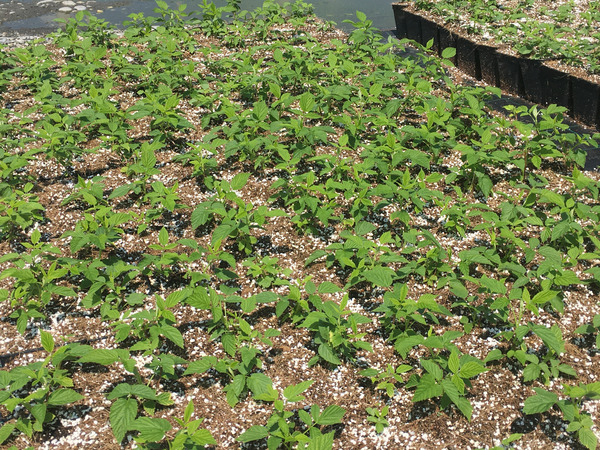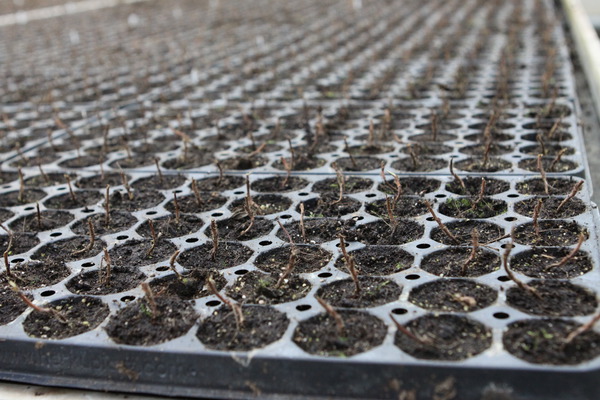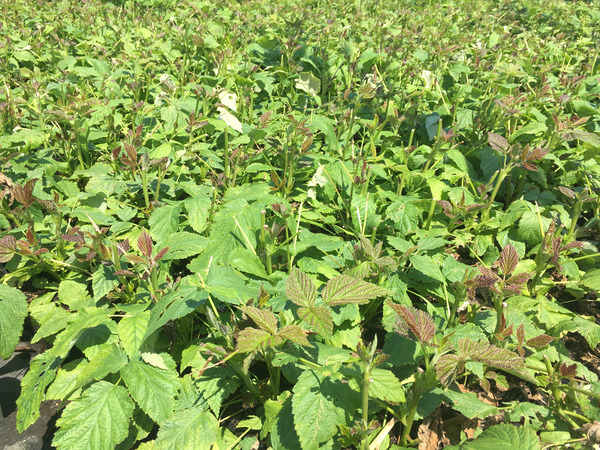 The past years have already indicated it and this year's “Corona spring” has confirmed it: the demand for 'edibles' – plants with edible parts – continues. Especially in this special year, there were phases in which the hunger for edible plants could hardly be satisfied, or in some cases not at all. Raspberries were particularly affected by these supply shortages, as they were hardly available, especially at the end of spring/beginning of summer. How could one prevent such supply shortages (which always mean missed market opportunities)? Or even more generally: how could the summer market be better utilised for edible plants? Because one thing is certain: it is a rather hopeless task to long for previous autumns with huge sales of woody plants…
The past years have already indicated it and this year's “Corona spring” has confirmed it: the demand for 'edibles' – plants with edible parts – continues. Especially in this special year, there were phases in which the hunger for edible plants could hardly be satisfied, or in some cases not at all. Raspberries were particularly affected by these supply shortages, as they were hardly available, especially at the end of spring/beginning of summer. How could one prevent such supply shortages (which always mean missed market opportunities)? Or even more generally: how could the summer market be better utilised for edible plants? Because one thing is certain: it is a rather hopeless task to long for previous autumns with huge sales of woody plants…
Fresh raspberry plants all year round – and not just for spring
One reason for the supply shortages of raspberries in late spring and early summer is the usual production method. Here the young plants are potted after the delivery phase in May/June and then cultivated and grown over the summer. However, the exact time varies considerably from company to company.
The plants produced in this way are then intended for delivery and sales in autumn or for stocking the sales areas in the spring. If, however, due to a lack of alternatives, plants from these stocks are sold in the summer, i.e. during the actual production phase, then these plants will be missing at a later date.

Picture: recently potted raspberry young plants of quality 'Multi', here in C1,3
Perhaps this should also be formulated more directly: because the entire production planning is ultimately geared towards spring sales, it is not possible to react flexibly to changing conditions, and finally there is no capacity to more actively treat the summer as a market.
The market for raspberry plants in the summer
Of course, one could argue now that the problem with summer sales is not that there are no plants, but rather that there is no demand at all. The search volumes on the internet (at Google) and also the sales results online indicate that the demand in the summer can be at a level of 35-50% of the peak sales in early spring. It is only reasonable to assume that this demand could also be realised to a large extent in terms of space – if the communication for this and, of course, the plants are available. Finally, there are various objective advantages of planting both raspberries and strawberries in the summer months.
Production in sets
With regard to the availability of plants for sale in late spring and summer, producing raspberry plants in sets can help. Although this production method slightly increases the planning effort, especially in the provision of pots, substrate and young plants, it is also a good idea to produce raspberry plants in sets. However, the advantages are more significant. For example, the downtimes of the individual sets can be reduced and fresh, vigorous plants can be offered and supplied all year round. This means that even in midsummer, which is actually the best time to plant raspberries in pots, retail outlets can be stocked with visually attractive plants. And one thing is for sure: the younger and shorter raspberry plants are produced in pots ranging from 12 cm to 3 L containers, the better they grow at the end customer.

Picture: Raspberry plants already well rooted and ready for sale at the end of July, potted at the beginning of June
Method A – The classic production method or the all-in-one solution suitable for every purpose
ere, our young plants (in the 'Multi+' and 'Multi' qualities) are potted in the classic way in May/June. The plants produced using this method can be offered at all sales dates. Depending on the pot size and pruning, the first cutting back of the plants can take place about 3 - 4 weeks after potting; the raspberry plants can be ready for sale after only a few weeks. It should be noted here that no actual cutting back measures should take place after 15th August, unless it is a discreet formation pruning to the sales height.
Method B – Selective potting of raspberries for summer sales
With this method, precise scheduling is essential. This is the only way to ensure that the right product is available at the planned sales date or promotion period. A pot size of 0.5 – 2 L is common practice, especially for special offers. Here, for young plants of the quality 'Multi' (fresh/herbaceous), a production period of about five weeks can be expected, provided that the plants do not need to be trimmed. If the plants do need to be trimmed, then the production time is increased to eight weeks.

Picture: Ready for sale raspberry plants in C1,3 (end of July), potting date was beginning of June
Method C – Potting in August (in a foil tunnel until September)
This potting date is suitable for all pot sizes recommended by us. Potting can be done outdoors (August) or in a protected area (September). Such a late potting date avoids negative weather conditions, such as extreme heat periods, as far as possible. However, the plants still have enough time to take root completely in the pot. And because of the short remaining growth period, the shoots of these plants do not become very strong. In this case, a complete pruning in the dormant season (January/February) is recommended. Plants produced in this way from a protected location will be ready for sale towards the end of April and from the open field from mid-May onwards, as it is necessary to wait until new shoots appear.
Method D – Potting overwintered young plants at the end of February/beginning of March
It goes without saying that only overwintered young plants of the 'Multi+' quality are suitable for this potting date. As our raspberry young plants are delivered at this time of year in a completely dormant state, they can be potted either in a protected, unheated location or directly outdoors. The raspberry young plants will then sprout with the normal seasonal cycle. Plants produced according to this method are ready for sale from a protected location from about mid-May and from the field from about the end of May/beginning of June.

Picture: Young raspberry plants of the quality 'Multi+'; here in absolute vegetation dormancy
Tabular overview
As you can see, there are ways and means of supplying retailers with visually appealing raspberry plants throughout the year. Contact us and we will be happy to help you plan your products and attractive, innovative assortments.
For a better overview, the individual production dates are listed below in tabular form.
|
Time of production |
Available young plants |
Location | Pot sizes | Production periode |
|
Method A – MaiyJune |
„Multi“ („Multi+“) |
Outdoors |
< 1l 1l – 2l > 2l |
4-5 weeks* 6-8 weeks* 8-10 weeks |
|
Method B – targeted for summer sale |
„Multi“ |
Outdoors Protected |
< 1l 1l – 2l > 2l |
4-5 weeks* 8-10 weeks* > 10 weeks |
|
Method C – August/September |
„Multi“ |
Outdoors Protected |
< 1l 1l – 2l > 2l |
4-5 weeks** 8-10 weeks** 8-10 weeks** |
|
Methode D – end of February/ beginning of March |
„Multi+“ |
Outdoors Protected |
< 1l 1l – 2l > 2l |
10-15 weeks 10-15 weeks 10-15 weeks |
*= up to a pot size of 1.5 L, the plants can be sold untrimmed; as soon as they are trimmed, the cultivation time will be extended by approx. 4-5 weeks
**= rooting time until dormancy in autumn
Trimming raspberries
Finally, a few words about trimming raspberry plants, because this can also endanger the success of the cultivation.

Picture: Raspberry plants grow again after trimming, easily recognizable by the red colour of the leaves; the older leaves, which remained on the raspberry plants after trimming, can also be easily recognized
When pruning raspberries, the following two main points should always be observed, as this is the only way to ensure a successful production.
- Never trim too low – only cut back the plants low enough to leave fresh green leaves on the plants. Completely leafless, pruned plants do not shoot as well, as there is no assimilation area left.
- Never cut back the plants after 15th August – plants that are pruned after 15th August will still sprout again, but the remaining time in the vegetation phase is too short for these shoots to mature completely. However, this time is rather adjustable, depending on the location of the company. In the northern latitudes, 5-8 days should rather be deducted from this date; in more southern latitudes, five days can be added. The exception to this rule is a decent and shaping cut to the sales height.
